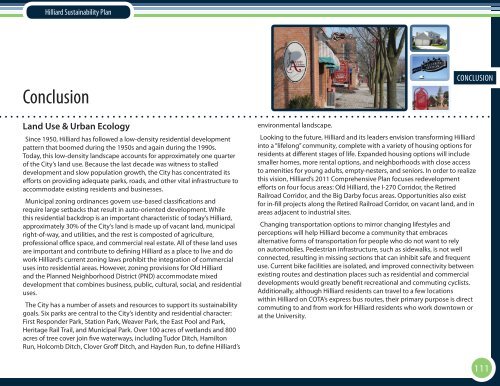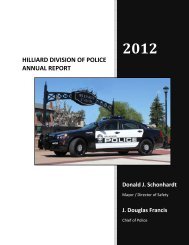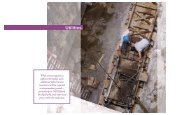The City of Hilliard Sustainability Plan
The City of Hilliard Sustainability Plan
The City of Hilliard Sustainability Plan
You also want an ePaper? Increase the reach of your titles
YUMPU automatically turns print PDFs into web optimized ePapers that Google loves.
<strong>Hilliard</strong> <strong>Sustainability</strong> <strong>Plan</strong>ConclusionLand Use & Urban EcologySince 1950, <strong>Hilliard</strong> has followed a low-density residential developmentpattern that boomed during the 1950s and again during the 1990s.Today, this low-density landscape accounts for approximately one quarter<strong>of</strong> the <strong>City</strong>’s land use. Because the last decade was witness to stalleddevelopment and slow population growth, the <strong>City</strong> has concentrated itsefforts on providing adequate parks, roads, and other vital infrastructure toaccommodate existing residents and businesses.Municipal zoning ordinances govern use-based classifications andrequire large setbacks that result in auto-oriented development. Whilethis residential backdrop is an important characteristic <strong>of</strong> today’s <strong>Hilliard</strong>,approximately 30% <strong>of</strong> the <strong>City</strong>’s land is made up <strong>of</strong> vacant land, municipalright-<strong>of</strong>-way, and utilities, and the rest is composted <strong>of</strong> agriculture,pr<strong>of</strong>essional <strong>of</strong>fice space, and commercial real estate. All <strong>of</strong> these land usesare important and contribute to defining <strong>Hilliard</strong> as a place to live and dowork <strong>Hilliard</strong>’s current zoning laws prohibit the integration <strong>of</strong> commercialuses into residential areas. However, zoning provisions for Old <strong>Hilliard</strong>and the <strong>Plan</strong>ned Neighborhood District (PND) accommodate mixeddevelopment that combines business, public, cultural, social, and residentialuses.<strong>The</strong> <strong>City</strong> has a number <strong>of</strong> assets and resources to support its sustainabilitygoals. Six parks are central to the <strong>City</strong>’s identity and residential character:First Responder Park, Station Park, Weaver Park, the East Pool and Park,Heritage Rail Trail, and Municipal Park. Over 100 acres <strong>of</strong> wetlands and 800acres <strong>of</strong> tree cover join five waterways, including Tudor Ditch, HamiltonRun, Holcomb Ditch, Clover Gr<strong>of</strong>f Ditch, and Hayden Run, to define <strong>Hilliard</strong>’sCONCLUSIONenvironmental landscape.Looking to the future, <strong>Hilliard</strong> and its leaders envision transforming <strong>Hilliard</strong>into a “lifelong” community, complete with a variety <strong>of</strong> housing options forresidents at different stages <strong>of</strong> life. Expanded housing options will includesmaller homes, more rental options, and neighborhoods with close accessto amenities for young adults, empty-nesters, and seniors. In order to realizethis vision, <strong>Hilliard</strong>’s 2011 Comprehensive <strong>Plan</strong> focuses redevelopmentefforts on four focus areas: Old <strong>Hilliard</strong>, the I-270 Corridor, the RetiredRailroad Corridor, and the Big Darby focus areas. Opportunities also existfor in-fill projects along the Retired Railroad Corridor, on vacant land, and inareas adjacent to industrial sites.Changing transportation options to mirror changing lifestyles andperceptions will help <strong>Hilliard</strong> become a community that embracesalternative forms <strong>of</strong> transportation for people who do not want to relyon automobiles. Pedestrian infrastructure, such as sidewalks, is not wellconnected, resulting in missing sections that can inhibit safe and frequentuse. Current bike facilities are isolated, and improved connectivity betweenexisting routes and destination places such as residential and commercialdevelopments would greatly benefit recreational and commuting cyclists.Additionally, although <strong>Hilliard</strong> residents can travel to a few locationswithin <strong>Hilliard</strong> on COTA’s express bus routes, their primary purpose is directcommuting to and from work for <strong>Hilliard</strong> residents who work downtown orat the University.111






